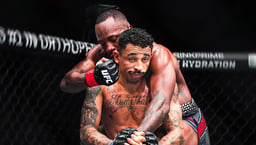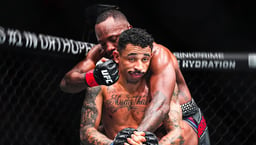
Issue 119
September 2014
Welterweights need a mix of lightning-quick reflexes and knockout power, and here’s how to get it...
Kevin Kearns S&C coach to 15 UFC, WEC, Bellator and Strikeforce fighters. Each issue he presents his best training tips
Now that Georges St-Pierre is on an extended sabbatical, the UFC welterweight division is wide open, and it’s going to be incredibly difficult for any of the current top contenders to fill the former champion’s shoes.
The 170lb division has always been one of my favorites because the fighters need to have the lightning-quick reflexes of the lightweights but the punching power of the heavyweights.
And to get that particular balance of zoom and boom takes a very particular brand of S&C training. Yeah, welterweights really have to put themselves through the meat grinder in training, which is, strangely enough, exactly what S&C coaches like myself tend to call them – ‘the meat grinders.’
But that’s not meant in any derogatory way, in fact it’s quite the opposite: it’s in recognition of how much they have to put their bodies through.
Of course, power and speed are vital for all MMA fighters, but whenever I work with a welterweight I tend to focus on their stamina, because I’ll generally engage with them towards the latter half of a fight camp, and they’ll have done
the majority of their strength work earlier on.
During this phase of conditioning it is important the fighter concentrates on sport-specific training; in others words, heavy deadlifts, bench presses and the like won’t get a look in. My job is to make sure they can out-work and out-last their opponent.
To do that I like to have them working with, of all things – resistance bands. And the reason? Simple: they’re adaptable for MMA moves, introduce multi-joint and multi-directional movement patterns, and build strength without bulk, among other things.
Generally, I’ll use GoFit Super Bands, Lifeline bands and a brilliant new piece of kit called a True Form. This is a handy device you wrap around your waist. Four slender bands then attach to your gym shoes – two to each foot.
Now while it won’t inhibit your movement it will provide extra resistance in near enough any movement involving your lower body. In short, it’s brilliant for when performing BJJ or wrestling drills.
Anyway, here’s a workout I
use regularly when working
with my welterweight clients. Wearing the True Form throughout, you should perform each exercise for 35 seconds before taking 15 seconds rest and moving onto the next. Perform four circuits to really reap the benefits.
1 Kneeling band punch
Attach a resistance band to a fixed point behind you. Take hold of a handle in each hand and place one knee on a Swiss ball before starting to let fly with the punches.
2 Pit-bull
With a heavy band attached to a fixed point and with the other end wrapped around your waist, get on all fours and then crawl forward.
3 Solo tug of war
With a heavy band attached to a fixed point a couple of inches off the ground, get down into a squat position and pull the band towards you, hand over hand, before letting it return to the start position.
4 Elbows in the guard
Lie on the floor with your legs crossed and slightly raised. Grab a band – already attached to a fixed point behind your head – with one hand and drive your elbow between your knees as you raise your legs.
5 Band uppercuts
Standing on top of your resistance bands, and holding an end in each hand, rotate your body from left to right and vice-versa while throwing uppercuts.
6 Thai knees with heavy bands
Attach a heavy resistance band to a fixed point near the ground behind you and then wrap it around your waist. Get into a fight-ready stance and then start launching alternate knees towards an imaginary opponent.
To really push yourself you could always perform a one-minute session on the pads between the second and third exercise and then a one-minute session of wrestling drills between the fourth and fifth exercise. Again, all while wearing the True Form or similar product.










